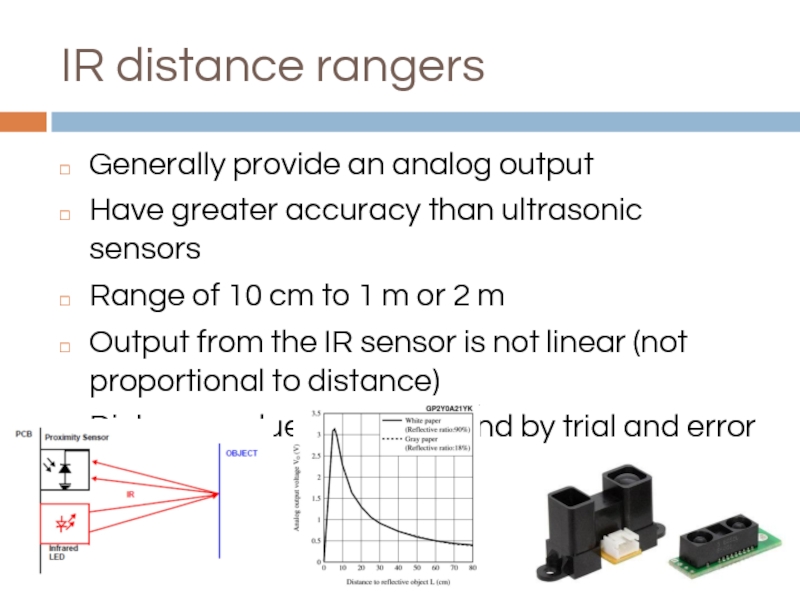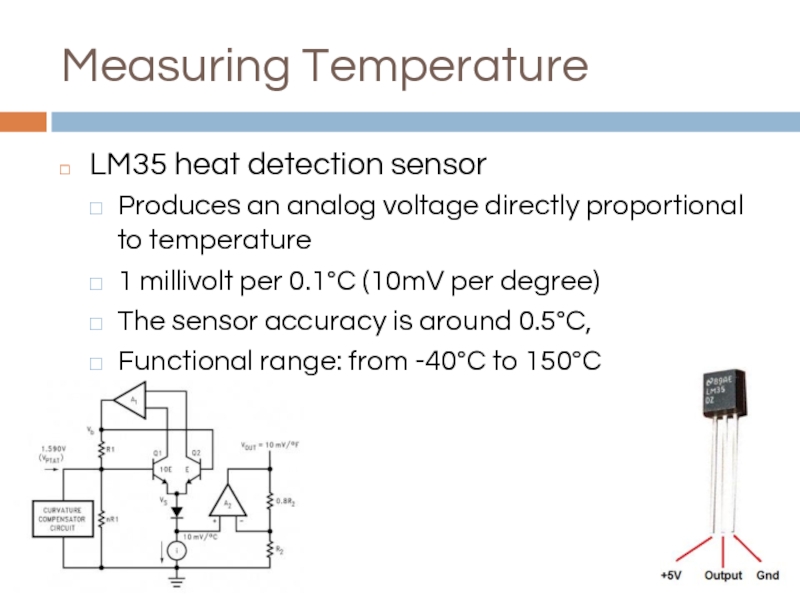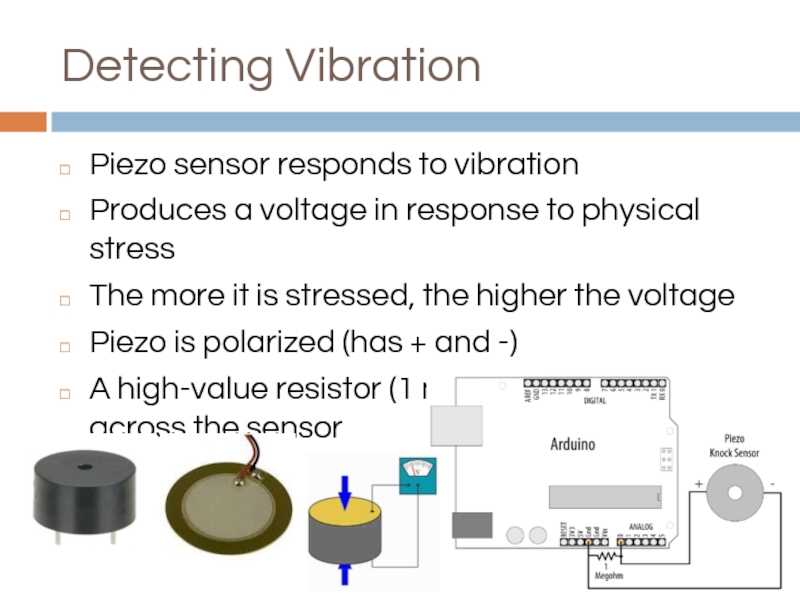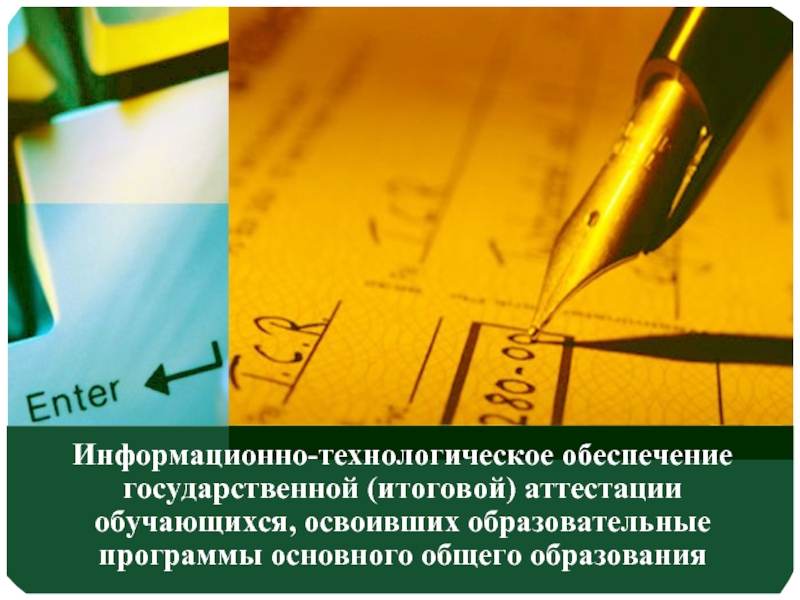- Главная
- Разное
- Дизайн
- Бизнес и предпринимательство
- Аналитика
- Образование
- Развлечения
- Красота и здоровье
- Финансы
- Государство
- Путешествия
- Спорт
- Недвижимость
- Армия
- Графика
- Культурология
- Еда и кулинария
- Лингвистика
- Английский язык
- Астрономия
- Алгебра
- Биология
- География
- Детские презентации
- Информатика
- История
- Литература
- Маркетинг
- Математика
- Медицина
- Менеджмент
- Музыка
- МХК
- Немецкий язык
- ОБЖ
- Обществознание
- Окружающий мир
- Педагогика
- Русский язык
- Технология
- Физика
- Философия
- Химия
- Шаблоны, картинки для презентаций
- Экология
- Экономика
- Юриспруденция
Getting Input from Sensors презентация
Содержание
- 1. Getting Input from Sensors
- 2. Getting Input from Sensors Sensors give report
- 3. Methods to provide information Digital on/off -
- 4. Methods to provide information Serial - provide
- 5. Consumer devices Contain sensors but are sold
- 6. Data sheets Contains information about a sensor’s
- 7. Noises Reading sensors from the messy analog
- 8. Detecting Movement Detect when something is moved,
- 9. Detecting Movement const int tiltSensorPin = 2;
- 10. Shake detection const int tiltSensorPin = 2;
- 11. millis() function Returns long type value -
- 12. Similar digital output sensors Mechanical switch sensors
- 13. Detecting Light Detect changes in light levels
- 14. Detecting Light Not full range of possible
- 15. When a room is getting dark const
- 16. Detecting motion const int ldrPin = A0;
- 17. PIR motion detection PIR - passive infrared
- 18. Measuring Distance Ultrasonic distance sensor Measure the
- 19. How it works Ultrasonic sensors provide a
- 20. Measuring Distance const int trigPin = 4;
- 21. pulseIn() and delayMicroseconds() pulseIn(pin, value[, timeout]) Reads
- 22. IR distance rangers Generally provide an analog
- 23. Measuring Temperature LM35 heat detection sensor Produces
- 24. Measuring Temperature const int inPin = A0;
- 25. Detecting Vibration Piezo sensor responds to vibration
- 26. Detecting Vibration const int sensorPin = A0;
Слайд 2Getting Input from Sensors
Sensors give report on the world around it
Sensors
The electrical signal depends on the kind of sensor and how much information it needs to transmit
Some use substance that alters their electrical properties in response to physical change
Others are sophisticated electronic modules that use their own microcontroller to process information
Слайд 3Methods to provide information
Digital on/off - switch a voltage on and
Tilt sensor
Motion sensor
Analog - provide an analog signal (voltage)
Temperature sensor
Light intensity sensor
Pulse width - measure the duration of a pulse
Distance sensors
Слайд 4Methods to provide information
Serial - provide values using a serial protocol
RFID
GPS module
Synchronous protocols: I2C and SPI
The I2C and SPI digital standards were created for microcontrollers to talk to external sensors and modules
These protocols are used extensively for sensors, actuators, and peripherals
E.g: compass module, LCD display
Слайд 5Consumer devices
Contain sensors but are sold as devices in their own
Provide sensors already incorporated into robust and ergonomic devices
They are also inexpensive as they are mass-produced
PS2 mouse
PlayStation game controller
Слайд 6Data sheets
Contains information about a sensor’s output signal
Available from the company
Google search of the device part number or description
Are aimed at engineers designing products to be manufactured
Usually provide more detail than you need
Information on output signal will usually be in a section:
Data format, interface, output signal, or something similar
Check the maximum voltage!!!
Слайд 7Noises
Reading sensors from the messy analog world is a mixture of
Use trial and error method to get a successful result
Common problem:
Sensor just tells you a physical condition has occurred
But not what caused it
Skills to acquire with experience:
Putting the sensor in the right context
Location, range, orientation
Limiting its exposure to things that you don’t want to activate it
Separating the desired signal from background noise
Use a threshold to detect when a signal is above a certain level
Take the average of a number of readings to smooth out noise spikes
Слайд 8Detecting Movement
Detect when something is moved, tilted, or shaken
Tilt sensor -
Ball bearing in a box with contacts at one end
Sensitive to small movements of around 5 to 10 degrees
Слайд 9Detecting Movement
const int tiltSensorPin = 2; //pin the tilt sensor is
const int firstLEDPin = 13; //pin for one LED
const int secondLEDPin = 12; //pin for the other
void setup(){
pinMode (tiltSensorPin, INPUT); //the code will read this pin
digitalWrite (tiltSensorPin, HIGH); // and use a pull-up resistor
pinMode (firstLEDPin, OUTPUT); //the code will control this pin
pinMode (secondLEDPin, OUTPUT); //and this one
}
void loop(){
if (digitalRead(tiltSensorPin)){ //check if the pin is high
digitalWrite(firstLEDPin, HIGH); //if it is high turn on firstLED
digitalWrite(secondLEDPin, LOW); //and turn off secondLED
} else{ //if it isn't do the opposite
digitalWrite(firstLEDPin, LOW);
digitalWrite(secondLEDPin, HIGH);
}
}
Слайд 10Shake detection
const int tiltSensorPin = 2;
const int ledPin = 13;
int tiltSensorPreviousValue
int tiltSensorCurrentValue = 0;
long lastTimeMoved = 0;
int shakeTime = 100;
void setup(){
pinMode (tiltSensorPin, INPUT);
digitalWrite (tiltSensorPin, HIGH);
pinMode (ledPin, OUTPUT);
}
void loop(){
tiltSensorCurrentValue=digitalRead(tiltSensorPin);
if (tiltSensorPreviousValue != tiltSensorCurrentValue){
lastTimeMoved = millis();
tiltSensorPreviousValue = tiltSensorCurrentValue;
}
if (millis() - lastTimeMoved < shakeTime){
digitalWrite(ledPin, HIGH);
} else{
digitalWrite(ledPin, LOW);
}
}
Слайд 11millis() function
Returns long type value - number of milliseconds since the
Will overflow (go back to zero) in approximately 50 days
Determine the duration of the event by subtracting the pre-stored start time from the current time
long startTime = millis();
…do something…
long duration = millis() - startTime;
Слайд 12Similar digital output sensors
Mechanical switch sensors can be used in similar
Float switch can turn on when the water level in a container rises to a certain level
The way a ball cock works in a toilet cistern
A pressure pad can be used to detect when someone stands on it
Слайд 13Detecting Light
Detect changes in light levels
Something passes in front of a
Detecting when a room is getting too dark
Use a light dependent resistor (LDR)
Changes resistance with changing light levels
Produces a change in voltage
This circuit is the standard way to use any sensor that changes its resistance based on some physical phenomenon
Слайд 14Detecting Light
Not full range of possible values (0-1023)
Since voltage will
LDR - simple kind of sensor called a resistive sensor
Range of resistive sensors respond to changes in different physical characteristics
It is important to check the actual values the device returns in the situation you will be using it. Then you have to determine how to convert them to the values you need.
Слайд 15When a room is getting dark
const int ldrPin = A0;
const int
const int darknessThreshold = 500;
void setup(){
pinMode (ledPin, OUTPUT);
Serial.begin(9600);
}
void loop(){
if(analogRead(ldrPin) < darknessThreshold){
digitalWrite(ledPin, HIGH);
} else {
digitalWrite(ledPin, LOW);
}
}
Слайд 16Detecting motion
const int ldrPin = A0;
const int ledPin = 13;
const int
int previousReading = 0;
int currentReading = 0;
void setup(){
pinMode (ledPin, OUTPUT);
Serial.begin(9600);
previousReading = analogRead(ldrPin);
}
void loop(){
currentReading = analogRead(ldrPin);
if(abs(currentReading - previousReading) > movementThreshold){
previousReading = currentReading;
digitalWrite(ledPin, HIGH);
delay(1000);
digitalWrite(ledPin, LOW);
}
}
Слайд 17PIR motion detection
PIR - passive infrared sensor
measures infrared light radiating from
Made from pyroelectric materials
which generate energy when exposed to heat
Слайд 18Measuring Distance
Ultrasonic distance sensor
Measure the distance of an object (2 cm
Modules includes ultrasonic transmitters, receiver and control circuit
Basic principle of work:
Trigger trig pin for at least 10us with a high level signal
The module automatically sends eight 40 kHz and detect whether there is a pulse signal back
Time of high output duration at echo pin is the time from sending ultrasonic to returning.
Слайд 19How it works
Ultrasonic sensors provide a measurement of the time it
Pulse width is proportional to the distance the sound traveled
The speed of sound is 340 meters per second - 29 microseconds per centimeter
Roundtrip = microseconds / 29
Distance in centimeters is: microseconds / 29 / 2
Слайд 20Measuring Distance
const int trigPin = 4;
const int echoPin = 2;
const int
long value = 0;
int cm = 0;
void setup(){
Serial.begin(9600);
pinMode(ledPin, OUTPUT);
pinMode(trigPin, OUTPUT);
pinMode(echoPin, INPUT);
digitalWrite(trigPin, LOW);
}
void loop(){
digitalWrite(trigPin, HIGH);
delayMicroseconds(10);
digitalWrite(trigPin, LOW);
value = pulseIn(echoPin, HIGH, 50000);
cm = value / 58; // pulse width is 58 microseconds per cm
Serial.print(value); Serial.print(" , "); Serial.println(cm);
digitalWrite(ledPin, HIGH);
delay(cm * 10 ); // each centimeter adds 10 milliseconds delay
digitalWrite(ledPin, LOW);
delay( cm * 10); delay(20);
}
Слайд 21pulseIn() and delayMicroseconds()
pulseIn(pin, value[, timeout])
Reads a pulse (either HIGH or LOW)
pin: the number of the pin on which to read the pulse
value: type of pulse to read: either HIGH or LOW
timeout (optional): the number of microseconds to wait for the pulse to be completed. Default is one second
Returns the length of the pulse in microseconds or 0 if no complete pulse was received within the timeout
delayMicroseconds(us)
Pauses the program for the us amount of time (in microseconds) specified as parameter
Слайд 22IR distance rangers
Generally provide an analog output
Have greater accuracy than ultrasonic
Range of 10 cm to 1 m or 2 m
Output from the IR sensor is not linear (not proportional to distance)
Distance values can be found by trial and error
Слайд 23Measuring Temperature
LM35 heat detection sensor
Produces an analog voltage directly proportional to
1 millivolt per 0.1°C (10mV per degree)
The sensor accuracy is around 0.5°C,
Functional range: from -40°C to 150°C
Слайд 24Measuring Temperature
const int inPin = A0; // analog pin
void setup() {
}
void loop(){
int value = analogRead(inPin);
Serial.print(value); Serial.print(" => ");
float millivolts = (value / 1024.0) * 5000;
float celsius = millivolts / 10; // sensor output is 10mV per degree Celsius
Serial.print(celsius);
Serial.print(" degrees Celsius, ");
Serial.print( (celsius * 9)/ 5 + 32 ); // converts to fahrenheit
Serial.println(" degrees Fahrenheit");
delay(1000); // wait for one second
}
Слайд 25Detecting Vibration
Piezo sensor responds to vibration
Produces a voltage in response to
The more it is stressed, the higher the voltage
Piezo is polarized (has + and -)
A high-value resistor (1 megohm) is connected across the sensor
Слайд 26Detecting Vibration
const int sensorPin = A0; // the analog pin connected
const int ledPin = 13; // pin connected to LED
const int THRESHOLD = 1;
void setup(){
pinMode(ledPin, OUTPUT);
Serial.begin(9600);
}
void loop(){
int val = analogRead(sensorPin);
Serial.println(val);
if (val >= THRESHOLD){
digitalWrite(ledPin, HIGH);
delay(100);
} else{
digitalWrite(ledPin, LOW);
}
}
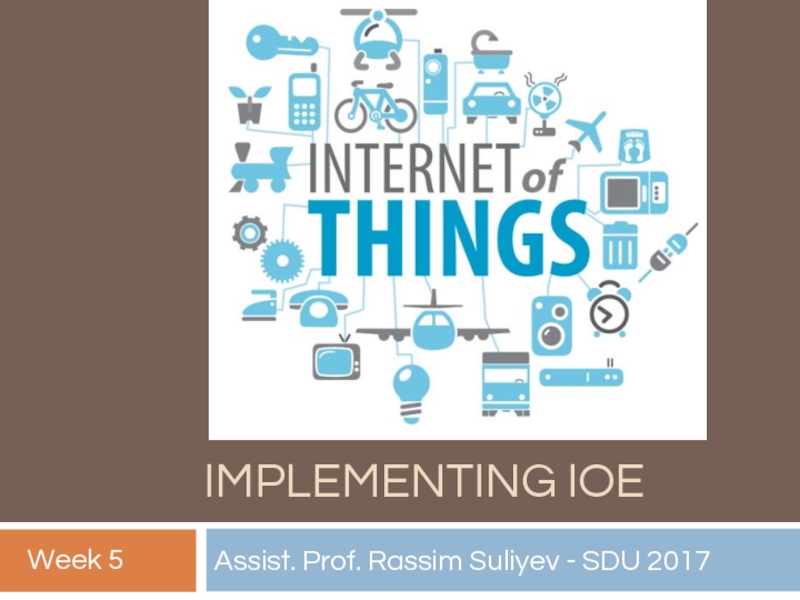
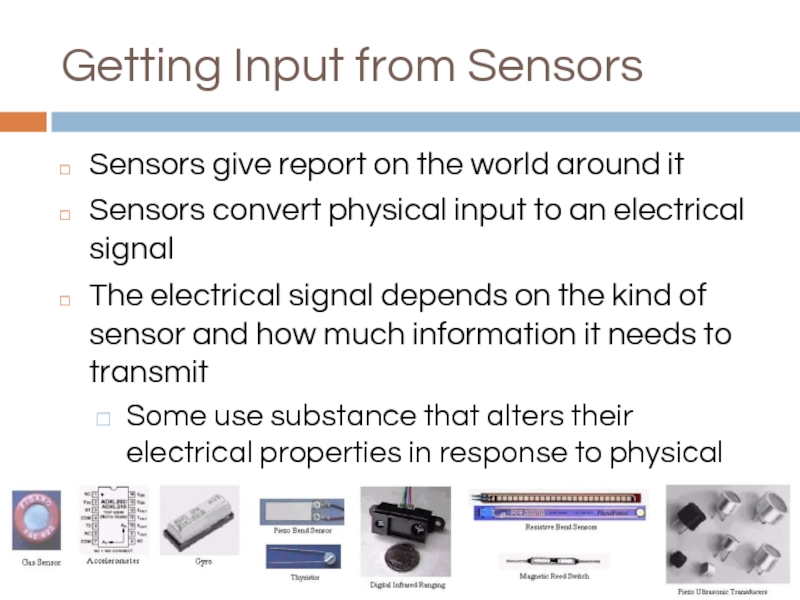
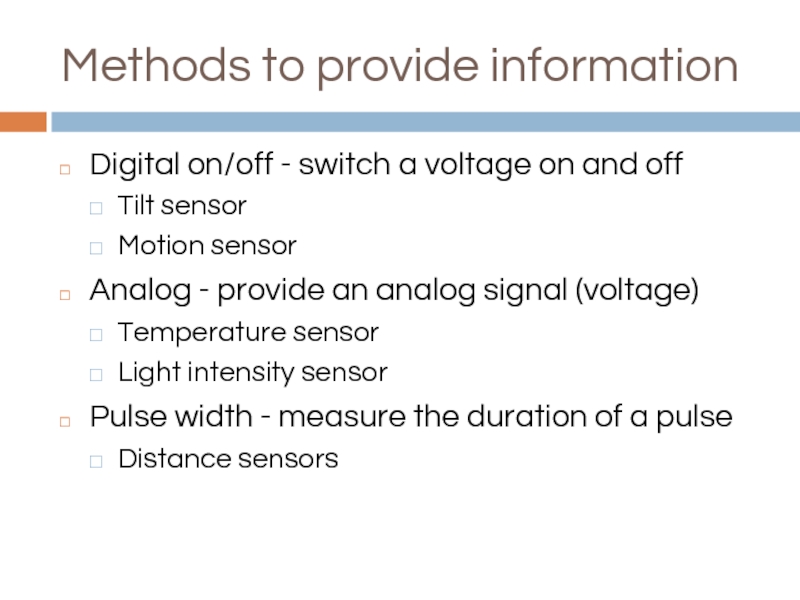
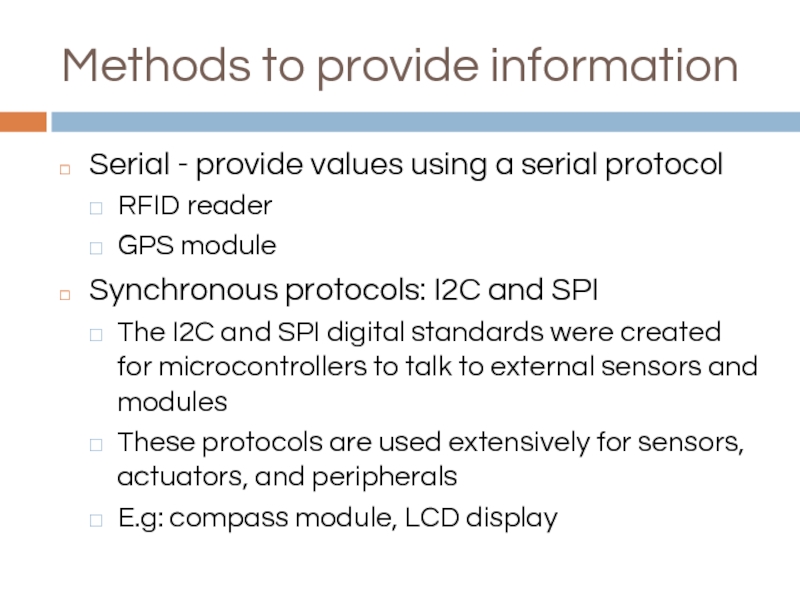
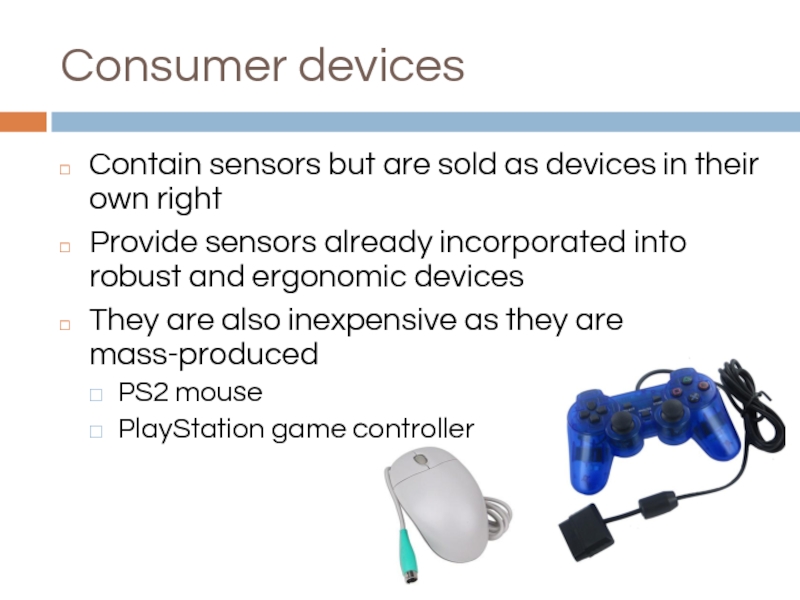
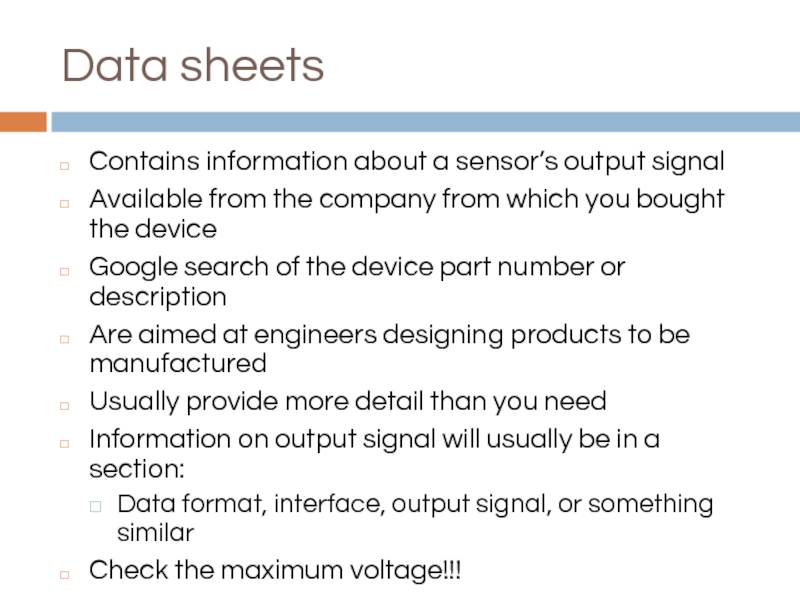
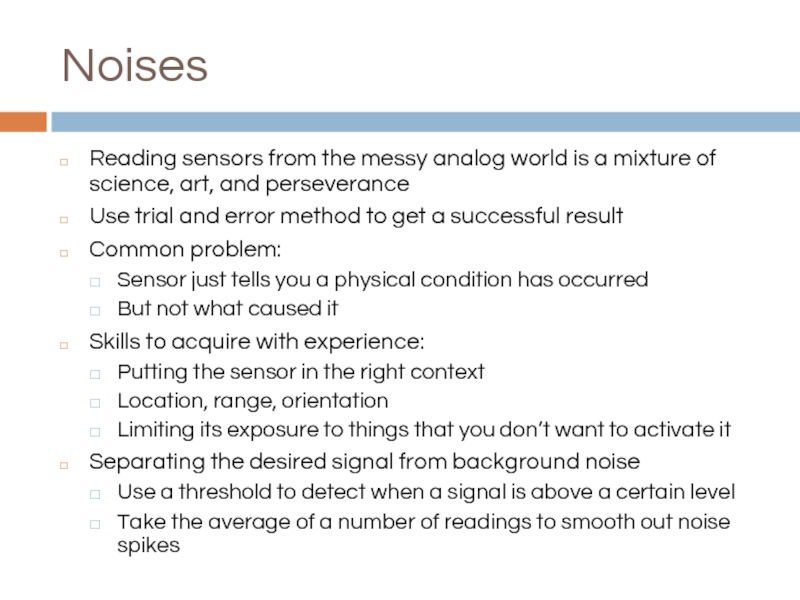

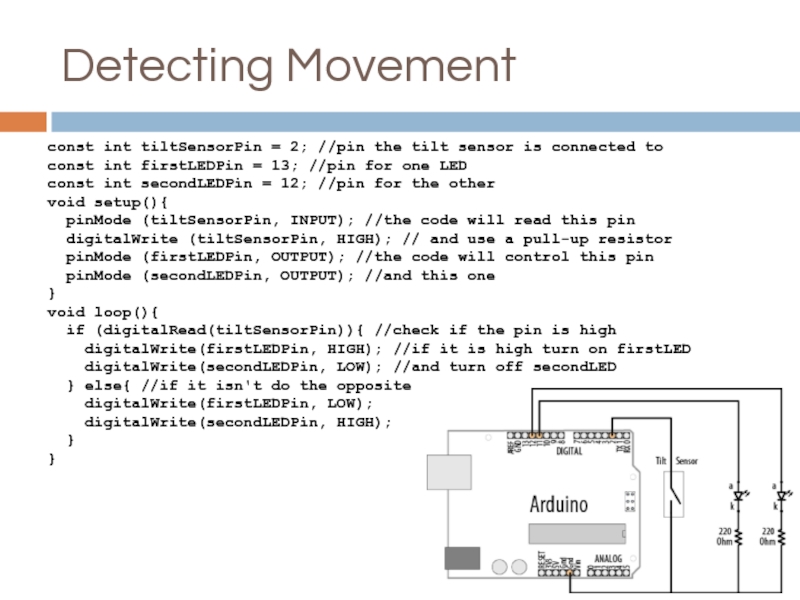
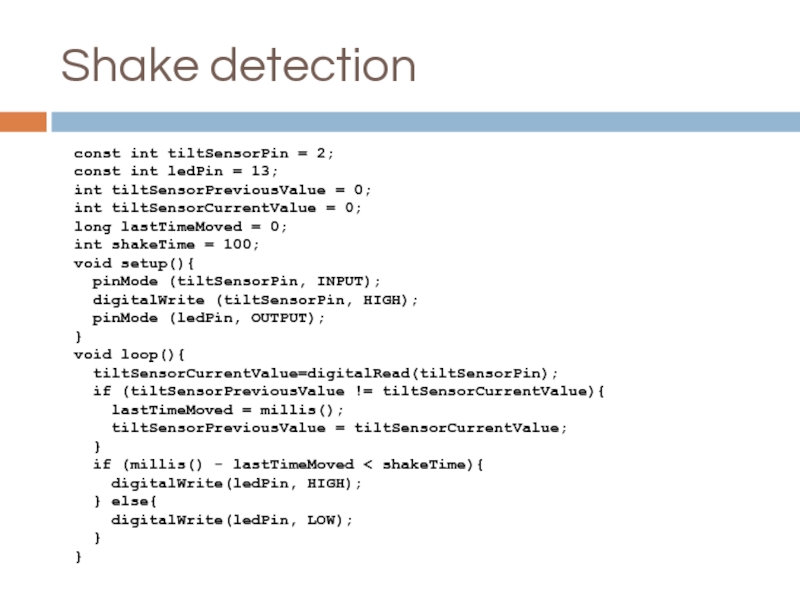
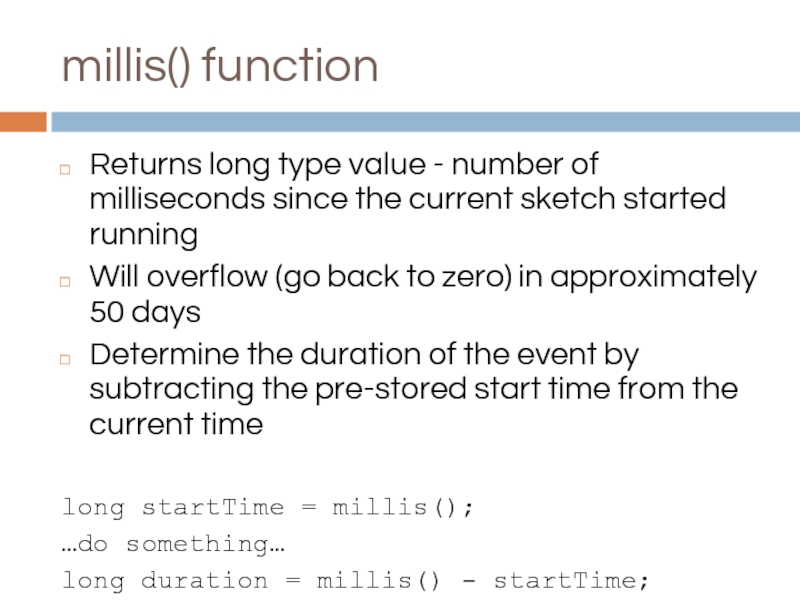
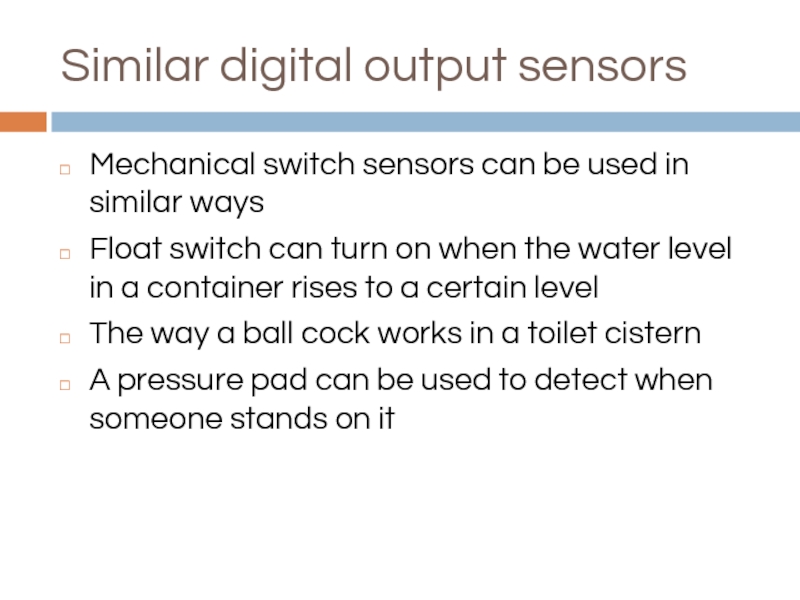
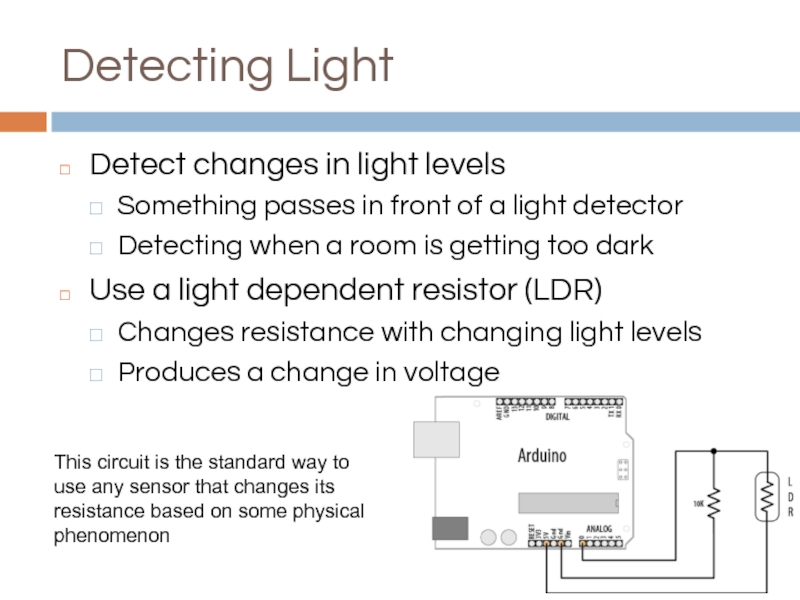
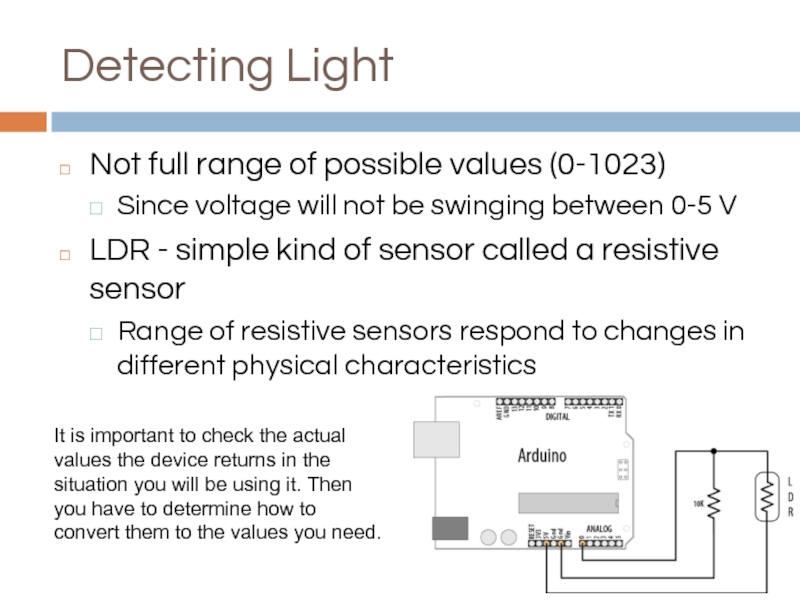
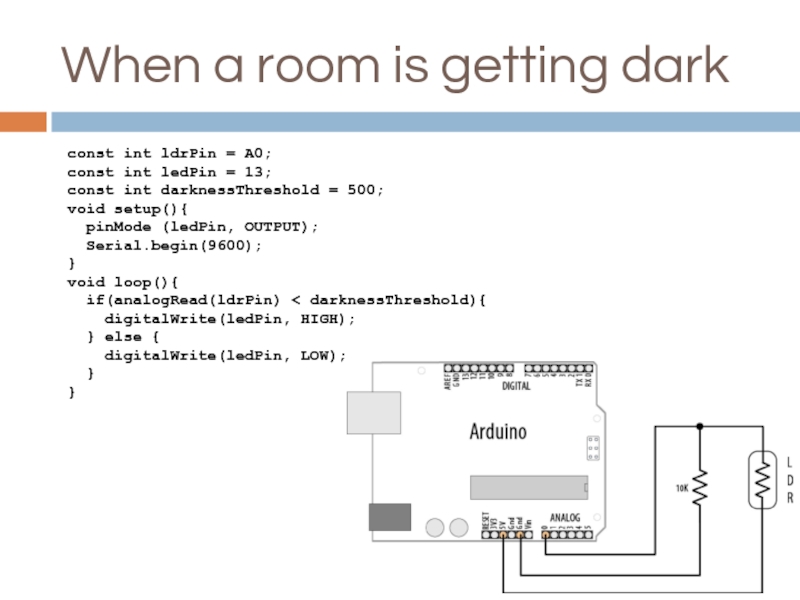
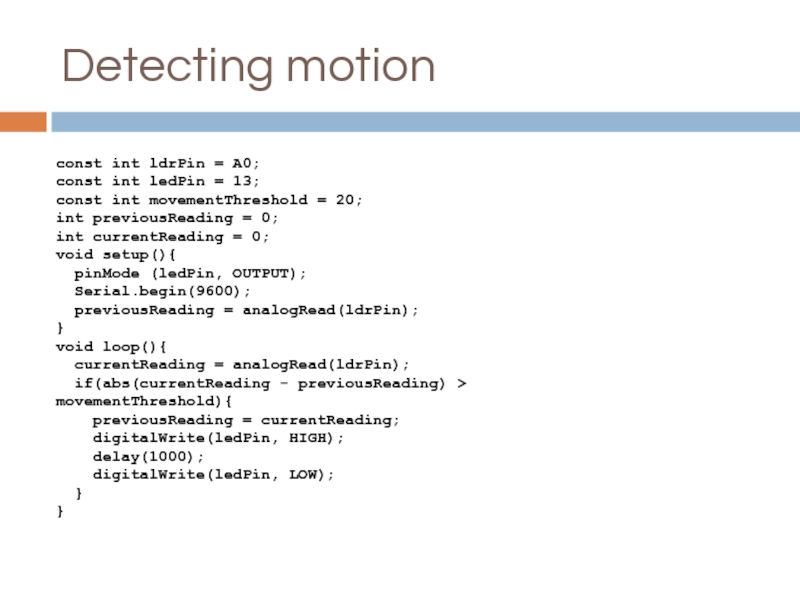
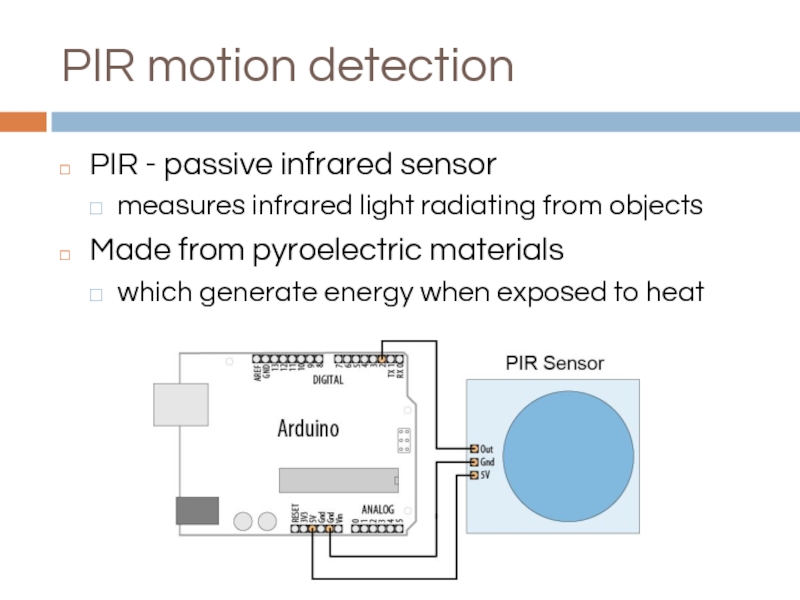
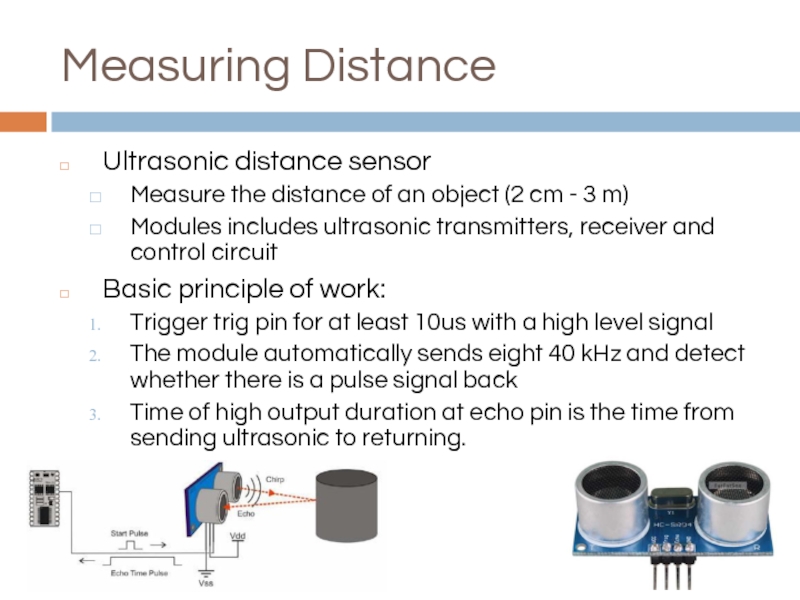
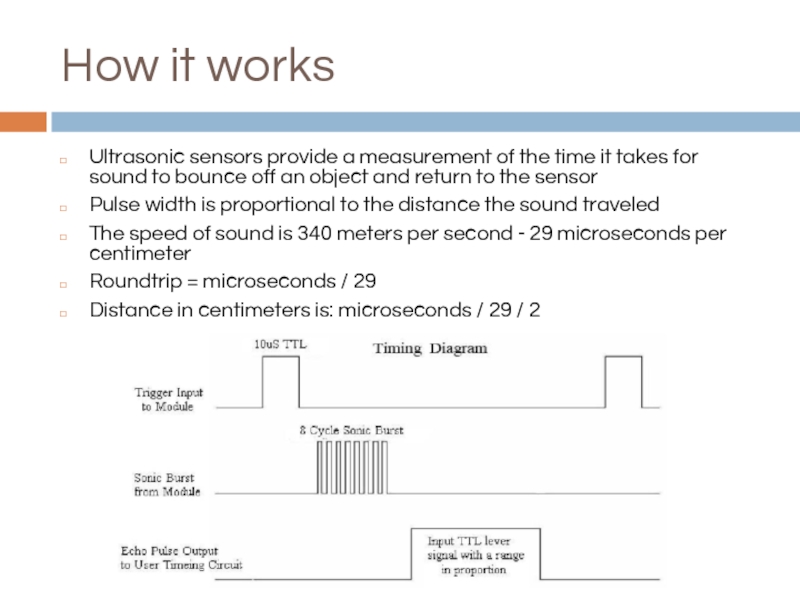
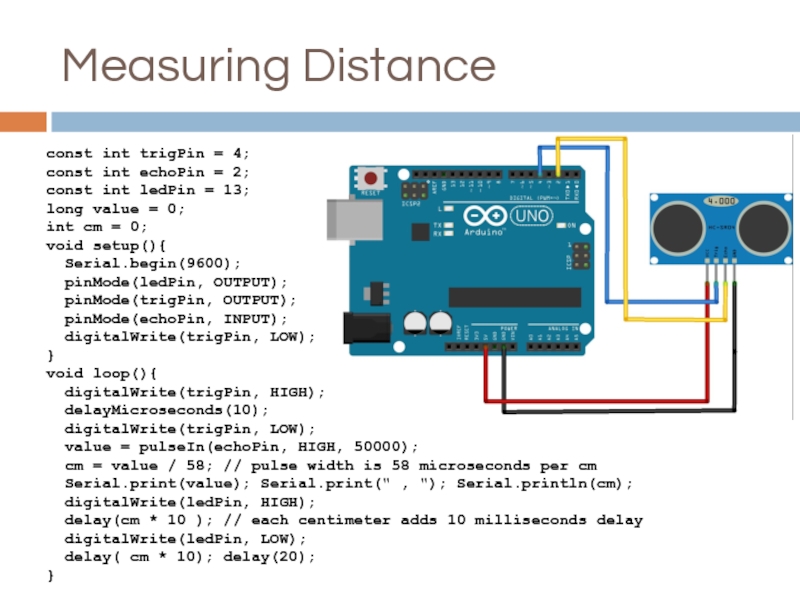
![pulseIn() and delayMicroseconds()pulseIn(pin, value[, timeout])Reads a pulse (either HIGH or LOW) on a pinpin: the](/img/tmb/1/34514/8ffb06ce4797a82f957ec25dafce0504-800x.jpg)
